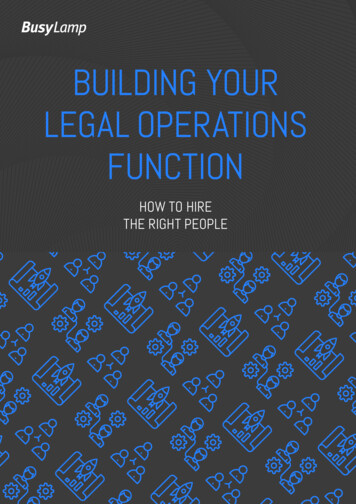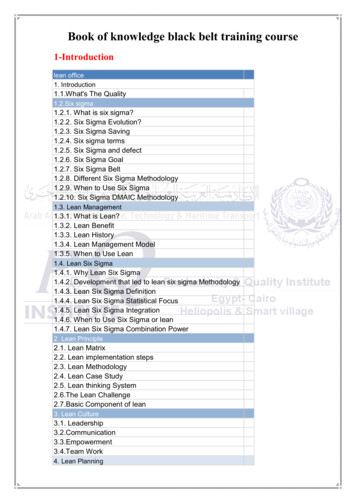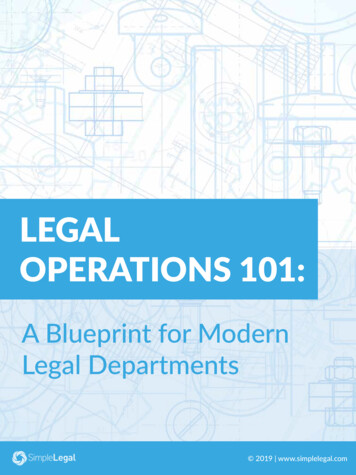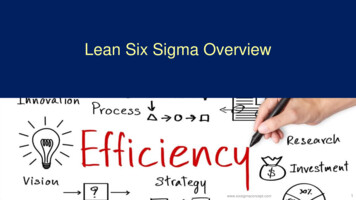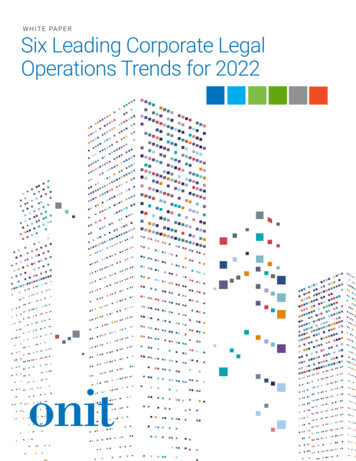
Transcription
W H I T E PA P E RSix Leading Corporate LegalOperations Trends for 2022
A worldwide pandemic forced legal operationsteams to get creative, pivoting to find newtechnology solutions for remote work andidentifying ways to maximize efficiency withoutincreasing headcount or risk.With the worst business impacts of thepandemic hopefully behind us, forward-thinkinglegal operations teams continue to build on thisevolution, accelerating transformation to helptheir organizations grow stronger than ever.This report compiles current data, metrics andtrends from leading legal operations reports intoone comprehensive guide. From bigger budgetsto prioritizing diversity and inclusion, closingcompliance gaps and beyond, it illustrates howlegal operations will take action to solve today's(and tomorrow's) most pressing challenges.1 Six Leading Corporate Legal Operations Trends for 2022
1Turning Larger Budgets into LegalSystem Road MapsIn Gartner's 2021 Legal Planning & Budgetingresponsibilities with limited resources. Thereport, legal operations members listedsame CLOC survey found that 55% of legal"technology solutions and level of adoption" asdepartment personnel handle more than fivesignificant weaknesses. They are working harddistinct business areas. The ratio of attorneysto change that, and larger technology budgetsto non-attorney legal operations professionalswill help.in U.S. organizations is 20:1 in mediumAccording to Gartner, corporate legalcompanies and 12:1 in small companies.departments are projected to triple their legalThe situation is even more imbalanced intechnology budgets from 2021 to 2025, whichEurope as companies establish dedicatedis a continuation of current spending trends.legal operations departments. While the overallThe Corporate Legal Operations Consortium'strend in companies having at least one person(CLOC) 2021 State of the Industryin legal operations is positive, 29% of globalReport found that the rate of technologycompanies recently surveyed still reportedimplementation across all areas in 2021 wasthat they include legal operations as part ofhigher than in 2020.someone else's role rather than a full-timeThis is good news for legal operationsposition.professionals, who often balance growing12 Six Leading Corporate Legal Operations Trends for 2022234TRENDS56
Motivations and Plans for TechnologyPurchasesAccording to the ACC 2021 Legal Technologyand documentReport for In-House Counsel, 88% of generalmanagement.counsel and CLOs in organizations earning 1BThese tools allowor more listed efficiency as the number onelegal operationsfactor in deciding whether it is time to purchaseprofessionals totechnology, far outweighing cost reductionspend less time(8%). Fifty-nine percent of in-house counsel inin spreadsheetssimilar-sized companies agree. While efficiencyand gain moreis important, legal operations professionalsaccurate, actionableare also keeping their eye on savings. Forty-business insights.six percent of them in 1B companies citeIn turn, that allowscost reduction as a technology purchasingfor better-informedmotivator.recommendations toWith this landscape in mind, legal operationsteams are looking to be more proactive andthoughtful with technology. Fifty-four percentof respondents in Deloitte's 2021 State of Legalthe C-suite, creates70%Percentage of CLOs wholisted legal operations asthe area of focus for theirdepartment’s top strategicinitiative.(Source: Association ofCorporate Counsel 2022CLO Survey)significant time andexpense savings anddecreases manual work.Operations Survey say they now have "a definedFinding the right solution for an organizationand actionable legal systems roadmap." Thiscan feel challenging with the sheer numbernumber is up from just 39% in 2020. Thirty-twoof tools to choose from in today's legal techpercent of respondents in the same survey alsomarket. One helpful approach is to find ansaid they now have tools to "provide actionableexperienced partner to identify recurring painKPIs and reporting without significant manualpoints, wish lists and an implementationeffort." This is a 10% increase from 2020.plan. Any approach – whether led internallyLegal operations are now prioritizingtechnology that automates and streamlinescritical workflows, reduces risk and enhancesdata collection and transparency. CLOC foundthat the most adopted legal technologies inor with a partner – should also consider otherdepartments that work closely with legal (likefinance, sales and the C-suite) to gain trulyenterprisewide benefits from your technologychoices.2021 were tools for e-signature, e-billing/mattermanagement, contract management13 Six Leading Corporate Legal Operations Trends for 2022234TRENDS56
2Forwarding Diversity and InclusionInitiativesDiversity and inclusion have been priorities inFor legal operations teams looking tothe legal industry for a good reason: althoughstrengthen diversity and implement effectiveit's been consistently shown that greaterD&I programs, the answer lies in both processdiversity leads to stronger work quality andand data, according to Bloomberg's 2021 Legalhelps businesses remain competitive, the legalOperations Survey. Three of the most commonsector has made little substantial progress.processes that were integral to buildingWhile the ABA's Model Diversity Survey founddiversity among respondents were:that "in-house counsel senior leadership hasshown a greater increase in diversity than Internal diversity traininglaw firms," just 11.5% of GCs at Fortune 1000 More remote work opportunitiescompanies in 2020 were racial or ethnic Changing recruiting patternsminorities, which was a 2% decrease from theprior year.Legal operations teams are increasinglyAs pandemic-driven budget constraints startinclusion efforts, with 71% of respondentsto ease, many legal departments are looking toincrease headcount by attracting and retaininga diverse talent pool. Indeed, the top prioritycited by legal operations professionals wasimplementing a diversity and inclusion (D&I)program.employing hard data in their diversity andciting plans to track diversity metrics. The mostcommonly measured diversity metrics continueto be race, gender and sexual orientation. Still,more and more legal operations teams areadding metrics in areas like neurodiversity topush inclusion even further.14 Six Leading Corporate Legal Operations Trends for 2022234TRENDS56
Encouraging Vendor Alignmentwith D&I InitiativesCreating a more diverse workforce in-houseis only the first step. Legal operations' buyingThree Companies Leadingthe Way in Keeping VendorsAccountablepower creates a unique opportunity to catalyzemore D&I in the law firms that represent them.Legal departments committed to improving D&Imust hold their external vendors, most notablylaw firms, to the same standards.That change is happening slowly but surely.In a CLOC report, D&I was one of the top threemetrics employed by legal operations teams toevaluate vendor performance formally.Intel will only hire vendors where atleast 21% of the firm’s U.S. equitypartners are women and at least 10% areunderrepresented minorities.Uber uses a preferred counsel programto track vendor progress in advancing itsD&I goals and “evaluates which attorneysare being placed on projects that will helpincrease their experience and seniority.”The RFP process can be invaluable in allowinglegal departments to gather the specificvendor diversity information they need to makeinformed decisions. Any legal department canstart by asking current law firm partners tocomplete the ABA Model Diversity Survey. Thisdata can then be stored, updated over time andNovartis AG requires that at least 30% ofbillable associate time and 20% of partnertime be completed by women, racial andethnic minorities and LGBTQ individuals.The company withholds 15% of the totalmatter amount if not.combined with new data collected via RFPs ina centralized legal solution that will serve as a"data repository to support future D&I efforts.If law departments want to promotediversity, they need to make sure thattheir law firms are walking the walk.That means taking steps up to andincluding firing law firms that fail tomeet diversity goals — and law firmsneed to believe they will."– Blickstein Group's 13th Annual LawDepartment Operations Survey15 Six Leading Corporate Legal Operations Trends for 2022234TRENDS56
3Closing Gaps in Data Protectionand ComplianceData breaches increased by 17% from 2020 tolaws, such as the European Union's General2021. Last year, the average cost of a breachData Protection Regulation (GDPR) and thereached an all-time high of 4.24 million.California Consumer Privacy Act (CCPA).While cybersecurity was a significant sourceof risk for most companies, only 57% of therespondents in this ACC survey report having a"comprehensive data management strategy toensure compliance, defensibility and security."IT should examine technical vulnerabilities,including those connected to remote workprotocols. The average cost of a data breachin 2021 was 1.07 million higher when remotework played a factor. Investing in a secure multi-Legal operations should play a critical rolefactor authentication tool is a necessary formin organizational cybersecurity, accordingof risk management, as these tools have beento Law.com, undertaking "a very deliberateshown to prevent up to 99.9% of cyberattacks.reexamination of how they are protecting theirIT can also review the security features of yournetworks and evaluating data privacy risks."legal technology options and decide whichLegal operations should partner with ITsolutions pose the least risk.to conduct a comprehensive audit of theIt's equally important to work with IT to create acompany's data security and privacy measures.robust change management plan to strengthenThe focus should be on assessing complianceyour cyber defenses. In 2020, 85% of datawith local consumer protection and privacybreaches involved a human element.16 Six Leading Corporate Legal Operations Trends for 2022234TRENDS56
%External Data Privacy RisksIt's also critical that legal operations teams assessexternal data privacy risks. Law firms continueto be major targets for cybercriminals due to theGlobal Perspectives: Europe’sApproach to Data Protectionand Compliancehigh volume of personal and sensitive client datathey possess. Despite the risk, the American BarAssociation found that only 43% of surveyedfirms use file encryption and just 39% use emailencryption and multifactor authentication.Legal operations departments should collaboratewith law firms on data security and nudge themto take necessary steps to improve data securityand privacy compliance, including working withIT to resolve data compliance and security gaps,requiring mandatory training on cybersecurity bestpractices and creating a breach response planthat aligns with the American Bar Association'sFormal Opinion 483: Lawyers' Obligations After anElectronic Data Breach or Cyberattack.Effective Privacy ComplianceData security was a central concern forEuropean legal departments before itbecame a priority for their U.S. counterparts.It has long played a significant role inshaping the vendor selection process. Itsimportance is only likely to increase asserious cyber events, like the recent Log4jvulnerability that took advantage of therisks presented by open-source software,continue to highlight the crucial importanceof data security – especially in light of thesignificant fines associated with GDPRnoncompliance.European legal operations departmentstherefore typically require all solutionsto meet country- and company-specificrequirements. U.S. companies can benefitby following their example.According to the Association of CorporateCounsel's 2021 ACC Chief Legal Officers Survey, thefollowing three strategies were the most effectivefor chief legal officers looking to ensure compliancewith data privacy regulations.Three Most Effective Strategies56.1%Implementing technologysolutions26.9%Increasing the use of outsourcednon-law firm vendors26.2%Internal restructuring17 Six Leading Corporate Legal Operations Trends for 2022234TRENDS56
4Attributing Real-World Results toAI AdoptionWhile it was once little more than a mainstayTo better understand the potential impactof Hollywood's rise-of-the-machines storylines,of AI, consider a leading area of technologyartificial intelligence (AI) is now an integral partinterest for corporate legal. According to theof how modern companies do business.ACC Legal Technology survey cited in sectionMcKinsey's State of AI in 2021 Report foundthat AI adoption is on the rise. The reportdiscovered that 56% of survey participantsacross multiple industries adopted AI in 2021,compared to 50% the previous year. Theadoption can have a significant impact on thebottom line. Twenty-seven percent noted thatthey could trace at least 5% of earnings beforeinterest and taxes (EBIT) to AI.one, 77% of the respondents said they wanttechnology to helpthem better managecontracts. Withefficiency beinga key motivatorfor technologypurchases, contractmanagement isa crucial area toCorporate legal departments are taking notetackle due to theof the mainstream phenomenon and itsoverabundancesuccesses. According to the CLOC State ofof manual work itthe Industry Reports, AI in-house usage hasusually requires.27%Percentage of users whonoted that they can traceat least 5% of earningsbefore interest and taxes(EBIT) to AI.(Source: McKinsey’s Stateof AI in 2021 Report)increased from 12% in 2019 to 22% in 2021,and the AI software market in the legal industryis predicted to grow by more than 28% between2021 and 2026.18 Six Leading Corporate Legal Operations Trends for 2022234TRENDS56
AI ResultsArtificial intelligence is a technology thatSimilarly, AIlearns, reasons and acts for itself. It can makesupportsdecisions that generally require a humancontractinglevel of expertise, and it helps lawyers andafter the deal islegal operations professionals anticipatesigned, reviewingproblems and address issues as they arise. It isthousandsparticularly suited for analyzing data, identifyingof contractspatterns and generating insight since itat once andleverages data to learn.exporting dataA study showed that legal contract reviewsoftware for first-party and third-partypaper makes new users immediately 51.5%more productive and 34% more efficient byconducting the first-pass review, makingredlines and delivering a risk profile. Accordingto the ACC, a typical midsize company has 55lawyers who collectively review an average of9,526 contracts each year. The productivityincrease allows the same legal team to process4,906 additional contracts each year – thein five secondsor less. Whenapplied to9%The percentage ofimproved profitabilitythat results from goodcontract development andprofitability.(Source: World Commerce &Contracting)tasks such asrepapering,batch review,legacy contractmigration and more, it can save in-housecounsel countless hours, ensure obligationsare met and help avoid the 9.2% average value"leakage" associated with today's contracts.equivalent of adding 28 lawyers to the team.19 Six Leading Corporate Legal Operations Trends for 2022234TRENDS56
5Exploring Alternative FeeArrangements (AFAs)Alternative legal service providers (ALSPs)continue to place increasing competitivepressure on traditional law firms, encouragingmany to become more amenable to alternativefee arrangements (AFAs) that give clients morecontrol over their legal spend. While AFAs arehighly beneficial to legal operations teams, aBloomberg legal operations survey found thatthey only apply to about 25% of current legalwork.Much of the resistance is coming from the clientside. Husch Blackwell chair Catherine Hanawayattributes the low prevalence of AFAs to legaldepartments being "skittish about agreeing toAFAs Are a Win-WinAFAs aren't just good businessfor clients. Law firms also standto benefit from them. For starters,they give law firms a significantcompetitive advantage whensubmitting RFPs. They also don'tmean lower revenue, as many mightbelieve – the average amount ofAFA revenue across Am Law 200firms has consistently increasedsince 2018.a number that's higher than what they would'vepaid with the hourly model." The Bloombergsurvey confirms this, with respondents citing"determining appropriate pricing" as their biggestbarrier to implementing AFAs.110 Six Leading Corporate Legal Operations Trends for 2022234TRENDS56
AFAs and OpportunitiesNone of this is surprising, as today's legalmore attractive they are. Including features likeoperations teams are hyper-focused on costcapped fees for complex legal matters can becontrol. Nonetheless, while it may take somepreferable to lower fees, which often come withadjusting, the payoff is worth it: AFAs like flatlower predictability.fees arrangements offer enormous benefitsThe best way to negotiate an AFA with your lawfor spend management over traditional billablefirm is by having hard data to fall back on. Legalhour models. For example, AFAs result in moreoperations teams can use spend managementreliable billing, allowing companies to stay onsoftware to compare the hourly rates ofbudget and avoid invoicing surprises.different vendors and analyze any current AFAsto determine objectively fair pricing.Client requests are the biggest drivers of lawfirm AFAs, and the more flexible they are, theTop Five Types of AFAs Used by Corporate Legal DepartmentsFixed fee bymatterFlat feeBlendedrateVolumeDiscountFixed fee byphase(Source: Bloomberg)111 Six Leading Corporate Legal Operations Trends for 2022234TRENDS56
6Creating Data-Driven VendorManagement ProcessesLegal operations teams have been laser-Legal technology can help bridge the gap.focused on optimizing spend, moving moreSophisticated software can assist legalwork in-house and prioritizing their returnoperations teams in establishing a formalon investment with their remaining externalvendor performance review process to ensurevendors throughout the pandemic. It should bethey're making the wisest spend choices.no surprise that GCs cited vendor managementLikewise, comprehensive software can helpas their top priority.legal departments track the vendor metricsDespite the stated importance of vendorrelevant to company success and spending.management, there's a disconnect: in CLOC'sState of the Industry Report, only 27% of legaldepartment respondents reported formallyreviewing law firm performance. Without clearguidelines for evaluating how well vendors aredoing, it's impossible for legal departments toaccurately determine the value of their ROI intheir vendor relationships.Read how ADM's self-built vendormanagement app standardizedvendor approval, automatedengagement letter creation andexecution and streamlined the RFPprocess.112 Six Leading Corporate Legal Operations Trends for 2022234TRENDS56
For instance, with a centralized, real-time legalplatform, legal operations can easily measurekey vendor data points, including: Compliance with billing guidelines Average lifecycle time per closed matter Accruals Staffing diversity Spend totalsAs one respondent in Deloitte's 2021 State ofLegal Operations Survey aptly summarized,objective vendor criteria allow legal operationsto "shift to a data-driven strategy in how weallocate work to firms and vendors instead ofrelying on relationships." Data-driven vendormanagement processes will always producebetter outcomes than anecdotal informationor limited personal experience. While invisiblebiases always influence human decisions,data-driven decisions lead to the best and most"cost-effective choices for your business.While many legal departmentsrelied on trusted law firm partnersto help interpret the regulatorychanges in the early months ofthe pandemic, they see increasingthe specialization of their teamsand bringing that work in houseas more cost-effective long-termsolutions."– Gartner113 Six Leading Corporate Legal Operations Trends for 2022234TRENDS56
Legal Operations Continue to Lead theCharge on TransformationAbout OnitOne trend continues to dominate: Legal operationsintelligence platforms and solutions for legal,are growing more critical every day. Surveyscompliance, sales, IT, HR and finance departments.show that corporate is providing legal operationsWith Onit, companies can transform best practiceswith additional resources – from personnel tointo smarter workflows, better processes andtechnology and beyond – to help their organizationsoperational efficiencies. With a focus on enterprisethrive.legal management, matter management, contractThe global pandemic has highlighted thenegative impact of inefficient processes andoutdated technology, giving stagnant teams (andC-suite members) more incentive than ever tochange. 2022 is the year legal operations willrally departments to embrace change and reachnew levels of growth. Not only will this help legaldepartments prove their value, but it'll help thecompany's bottom line.Whether it's evaluating enterprise legalmanagement software, streamlining contractmanagement or starting formal vendor anddiversity programs, these new actions will separatethe most successful legal ops teams from the onesthat fall — and stay — behind.14 Six Leading Corporate Legal Operations Trends for 2022Onit is a global leader of workflow and artificiallifecycle management and legal holds, the companyoperates globally and helps transform the wayFortune 500 companies and billion-dollar corporatelegal departments bridge the gap between systemsof engagement. Onit helps customers find gains inefficiency, reduce costs and automate transactionsfaster. For more information, visit www.onit.com orcall 1-800-281-1330.
The Corporate Legal Operations Consortium's (CLOC) 2021 State of the Industry Report found that the rate of technology implementation across all areas in 2021 was higher than in 2020. This is good news for legal operations professionals, who often balance growing . responsibilities with limited resources. The . same CLOC survey found that 55% .

